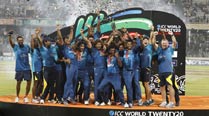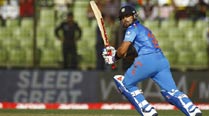 Cheteshwar Pujara (144 not out) hit his 12th Test hundred. (AP Photo)
Cheteshwar Pujara (144 not out) hit his 12th Test hundred. (AP Photo)
Early in the morning session, off the last ball of the 14th over. Shikhar Dhawan’s thick edge flew like a stray bullet through the slips, grazing an outstretched Asela Gunaratne’s thumb. Dhawan sighed in relief. The young Sri Lankan writhed in pain. Dhawan eventually scored a breathtaking 190. The Sri Lankan was driven to Colombo for an emergency surgery. The knock would extend Dhawan’s Test career. The blow would rule Gunaratne out for four weeks. Sri Lanka, effectively, will play with 10 players for the remainder of this Test.
It symbolised how the game rolled out over the day, as Sri Lanka never recovered from the setback. As the shadows lengthened and the sea breeze flitted through the ground, they lumbered into the dressing room nursing their wounds; Ajinkya Rahane and Cheteshwar Pujara, after extending India’s score to 399/3, retreated to the pavilion content and laughing, sustaining the dominance Dhawan had asserted until he perished an over before tea. It looks like an impregnable position for India, even if you consider the ground’s notorious mood swings, like it did in the last Test featuring these two sides in 2015. In that particular Test, India, after bundling Sri Lanka for a meagre 183, were 255/2 at one stage, both Dhawan and Kohli polishing off hundreds, before a stirring comeback by the hosts.
It would take an outstanding effort for the Lankans to pull off a heist of such dramatic proportions. For India seems in utter control at the moment, with two of their finest builders out in the middle to pile on more runs and agony on the second day, especially as the strip looks benevolent and bereft of any demons. The Sri Lankan bowlers, both spinners and pacers, could hardly extract any purchase off it. There were a couple of brownish, dry grass patches, around the good-length area for the fast bowlers, but they didn’t offer any hint of assistance whatsoever.
An unhelpful track
Their fast bowlers were also culpable of not probing that area often enough in the first session. Instead, they kept banging it in, only to be ferociously pulled by Dhawan, and sliding down the leg side. The two edges they produced in the morning — Mukund’s which they pouched and Dhawan’s they grassed — were rare instances of them pitching in the corridor and extracting some movement. On an unhelpful track as this, they didn’t have the patience, discipline or heart to strangle batsmen with tight bowling allied with smart field settings. Instead, they surrendered too early and too easily. Their manager Asanka Gurusinha summed their malaise as “bowling well only in patches and not striking the good areas”.
It was a mild way of putting it. It was rather a case of bowling a few good balls, forget patches or spells. Consequently, at no point did they put Indian batsmen under any sustained pressure.
What they are tasked with now is to prevent Rahane and Pujara, who have already bunched together 113 on the board, from stacking up big runs, that might push Sri Lanka out of the match. So overwhelming was Dhawan’s knock that it doesn’t even register that Pujara hoarded 144 runs, at a brisker speed than he normally does. It’s tempting to call it a phantom hundred, because Pujara went about his job almost invisibly.
If Dhawan’s knock was all about swagger and braggadocio, like the vengeful surf that lashes onto the beach front, Pujara’s was sweet and serene, without too many excitable moments or jumpy hiccups. It was a methodical and measured effort. Apart from the first ball he faced, which squirmed off the outside half of the blade to the ropes, as it came slower than he expected, Pujara seldom looked uncontrolled. There was all the characteristic clockwork precision and steadfast resoluteness, the curly flicks and serviced drives. With Dhawan, he was content rotating the strike and essaying an occasional boundary, mostly when the ball was full or strayed on the legs. With Rahane, it was more of controlled Test match batting.
Likewise, Rahane, who had a somewhat lean home season, looked more fluent than he has done in the last six months, driving and sweeping serenely, sending Sri Lanka ominous signs for the second day. Gurusinha, though, is hopeful of a turnaround, “You never know. This is Galle and after scoring 600 runs, you can still lose a Test match,” he warns. But it seemed more optimism than genuine hope. And Sri Lanka might do well to draw this match, forget winning it.

